
Parks Canada shipwright Terry Karlsen stands on the deck of the S.S. Klondike paddlewheeler overlooking the Atlin Barge at the S.S. Klondike National Historic Site in Whitehorse, Yukon/Jennifer Bain
Editor’s note: This update provides clarification from Parks Canada in paragraph 22 on how environmental contaminants, such as lead, are handled by the agency.
The Atlin Barge was usually the last thing that people noticed when they came to the banks of the Yukon River to gush over Whitehorse’s most iconic attraction — a vintage, steam-powered paddlewheeler.
To some, the Atlin was just a curious heap of rotting wood or just part of a wooden patio along the river. To others, it was an obsolete tool that was once cheap and easy to build.
To Parks Canada, though, it’s the only known survivor of the many wooden barges that once plied the Yukon River watershed moving mining equipment, food, supplies and people between 1898 and 1950. That’s why it ended up on the S.S. Klondike National Historic Site with the paddlewheeler that travelled the river from 1929 to 1955, a visitor centre, 60-seat theater, grassy triangle of land and parking lot. The site draws 40,000 visitors a year and the S.S. Klondike is so iconic, it's on the city's coat of arms.
Enter shipwright Terry Karlsen, one of the few remaining wooden boat builders in Canada. He saw the damage that rain, snow and fluctuating humidity levels had done to the Atlin’s hull, and then came up with a plan to bring it back to life.
The Traveler spoke with Karlsen — a technical services officer for Parks Canada — in September in Whitehorse, the capital of the Yukon. He figures it will take up to five years to complete work on the Atlin and Klondike, unless he can somehow extend the short work season through the harsh winters.
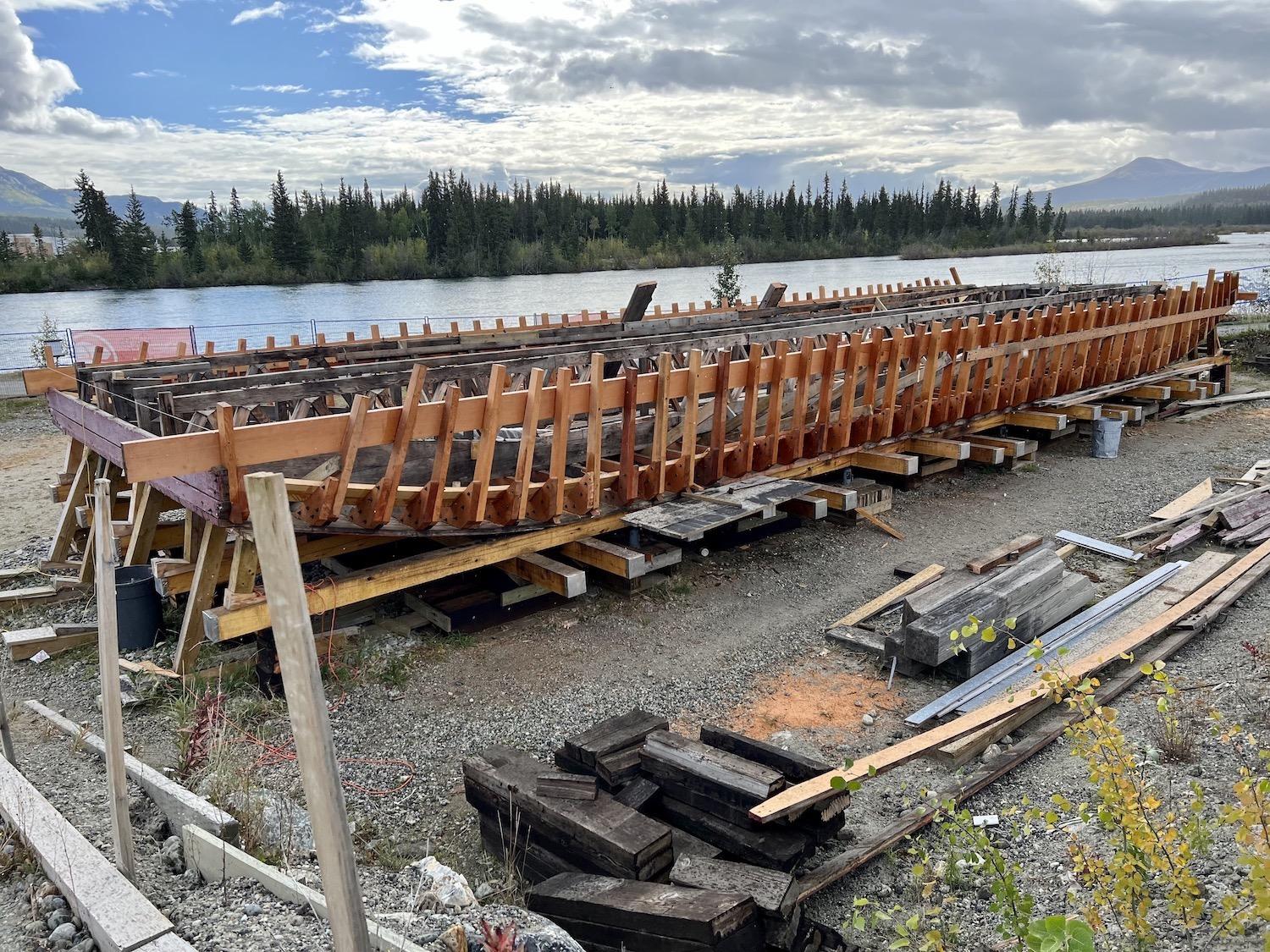
Shipwright Terry Karlsen and his crew are diligently rebuilding the Atlin Barge/Jennifer Bain
So tell us about this barge?
This is the Atlin Barge. This particular one was rebuilt in 1935 for the original Atlin Barge. As usual, during the Gold Rush, these types of items were just tools, right? They just used them for hauling freight. So this is the last one left in the Klondike. I think there was upwards of 50. And after the Gold Rush was over, the Alaska Highway went in and the paddlewheelers kinda seen their last day, a lot of the barges got sold off to private companies and stuff. So they just ran them into the ground and probably left them on the beach where they sank. This one came back to us, I think in the ‘70s, and this is basically the last remaining one.
How did it come back. What do you mean?
It went to private hands and then I think Parks (Canada) recognized that, you know, that this is kind of the last barge that’s left — we’d better get a hold of it. So I don’t know how they got it. It was probably so badly derelict and the owner’s like “here you go.” It was brought here shortly after the Klondike was brought here and it’s just basically been sitting here ever since. It basically was rotted out.
Has it always looked like this?
No, I’ve got some old pictures of it. Basically, it was rotted out. I’ve worked on a lot of wooden schooners, ocean-going tugs — I mean the whole gamut — and this was probably the worst. I couldn’t figure out why it was busted up so bad. It just didn’t make sense and then I got an email the other day and an old fella back in the ’50s — I think he was like 14 or something — he was standing up on the bank, and the first big diesel shovel that come into the Yukon was put on this and it went through the deck. So it broke the back of the barge, which is why everything was completely destroyed. So it's been a bit of a war getting this thing reconstructed, but being the last one of its kind, I think it's important that we restore and preserve this kind of stuff, right, for future generations to see how, I mean basically how this whole territory was built with that (the paddlewheeler) and with this (the barge). And it’s a good starting learning point for the crew on boat building. It’s very simple but it still requires some steam bending and you’ve got to understand lines and rakes and shears and all that kind of stuff.
You work with a crew of how many?
I’ve got three guys, three people.
And they’re all with Parks Canada?
Correct. So traditionally they would contract all this stuff out and I’m like how are we going to maintain all this stuff into the future if we need to rely on contractors, which there’s not many wooden boat builders left that work on stuff of this scale. And like the only way forward is to start training ourselves internally and learning how it’s done, and they have to pass that knowledge on to a future crew and then we can maintain this stuff well into the future, right?
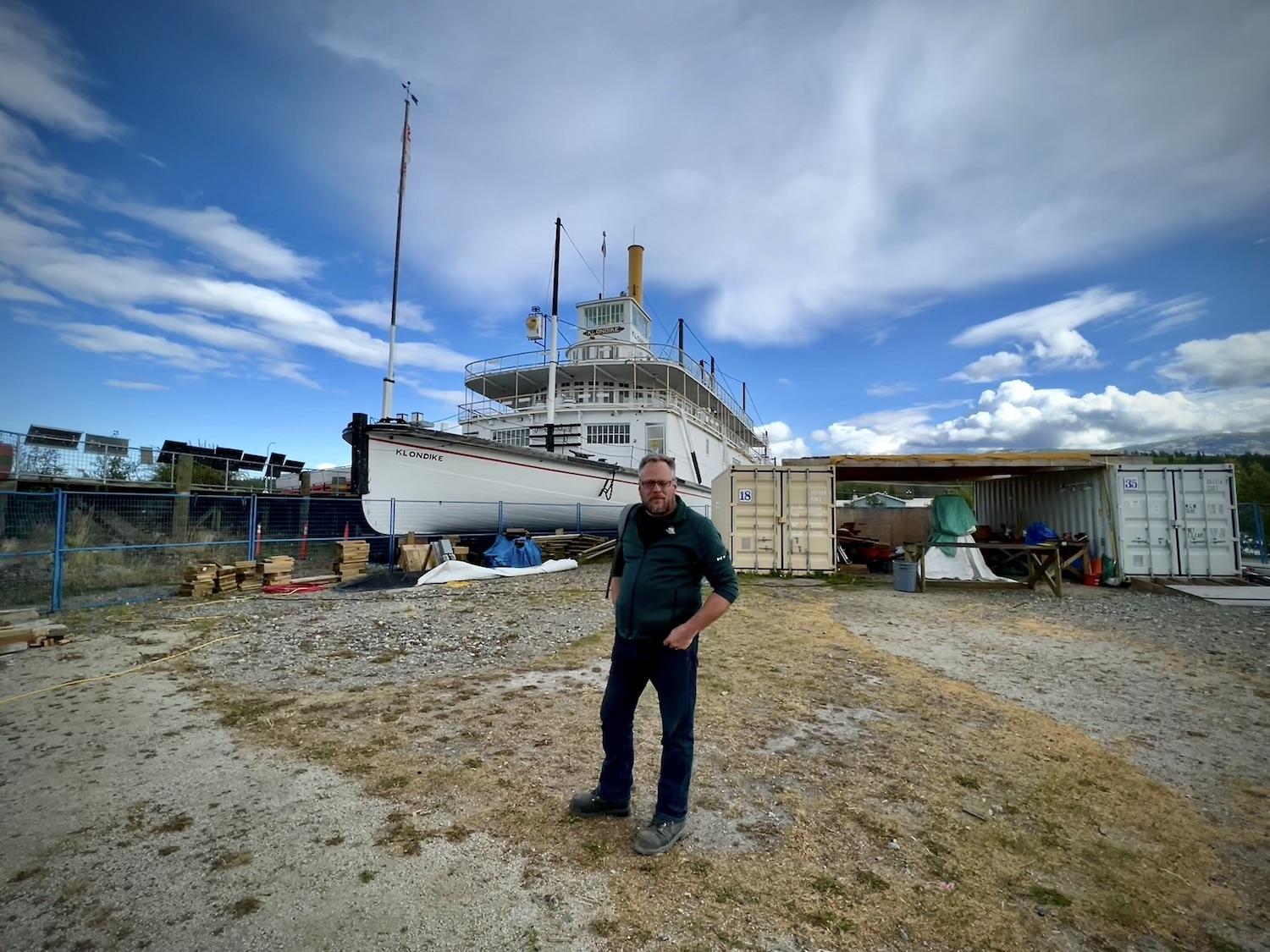
Between the S.S. Klondike and the Atlin Barge, shipwright Terry Karlsen has his work area where every scrap of lumber is put to good use/Jennifer Bain
Are you the only shipwright then for all of Parks Canada?
For all of Parks Canada.
And when you say there’s not many wooden boat builders working on this scale, meaning this is small scale?
It means this is a big one. I would say probably, right now in North America, that’s the largest wooden boat restoration that’s happening — the S.S. Klondike, 240 feet. It’s about 75-feet tall at the top of the stack and 40 feet wide. It’s a big job. And wooden boat building is going by the wayside, you know? There’s not much more of it happening of it anymore. The older wood boats on the coast and stuff, they’re at the point where most people don’t want to fix them so they just get stuck in a dumpster. So it’s a lot of aluminum, steel, fibreglass, carbon fibres, things like that, right? And you know the wood product isn’t as readily available anymore as it was back in the day. It’s a very specific grade of wood that goes into boat building.
Tell me about the wood.
Well, it’s got to be old growth, number one. So tight ring, no sap, no knot, straight grain, for all the steam bending and stuff that you have do with the planking or the decking. And it’s less prone to rot. And it’s got to be air dried. So when you buy the big lifts of wood everybody’s like oh we’re going to get working. No, no. Actually, we’re going to wait for a year and a half, two years, for this stuff to season in order to use it in the boat. So it’s quite the process, right?
What type of wood is it?
These traditionally were all Douglas fir, and the reason why they were all Douglas fir is because back at the turn of the century and stuff they were logging vast amounts of it. It was all in the valley bottoms. It was the easiest tree to get a hold of. Structurally it’s very sound but it is prone to rot. But like I was mentioning, even the Klondike, the barge — they were just tools so when they wore out, they just built a new one and kept going, making money, right?
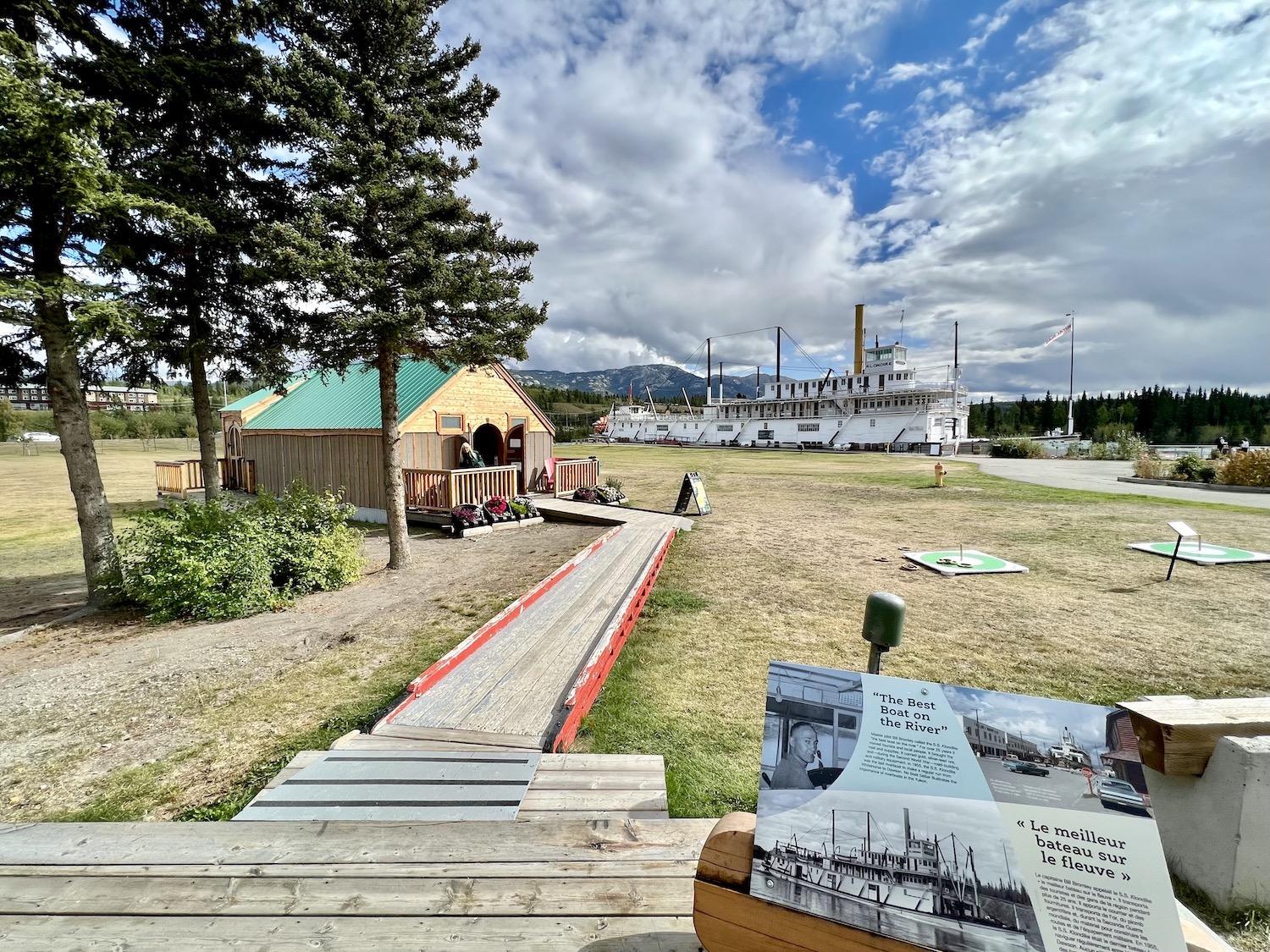
The S.S. Klondike National Historic Site is a large patch of riverside land that showcases the paddlewheeler and barge and has a new wooden theater built by Terry Karlsen/Jennifer Bain
If it was traditionally Douglas fir, what is it now?
I’m going to be using yellow cedar which is more readily available, very structurally sound and has a high degree of rot resistance. So the longevity of the vessel — it’s going to see a lot more years before things have to be replaced. It’s funny because a lot of guys talk about Douglas fir, saying “oh it’s the only thing to use for framing.” But I’ve done a lot of ocean-going tugs from the turn of the century and they’re all framed in yellow (cedar). All the internal structure for the barge is yellow, right? It has a lot more movement. So unlike a building, a boat’s got to be able to move on all its axes at one time. They tend to last a lot longer.
And is it sourced from Canada?
Correct. Most of it comes from the west coast of British Columbia. A lot of the wood that you see in these vessels actually came from Oregon because there were bigger logging operations and timber was more readily available than in B.C. at that time.
So the original Douglas fir is the stuff that’s from Oregon?
Correct.
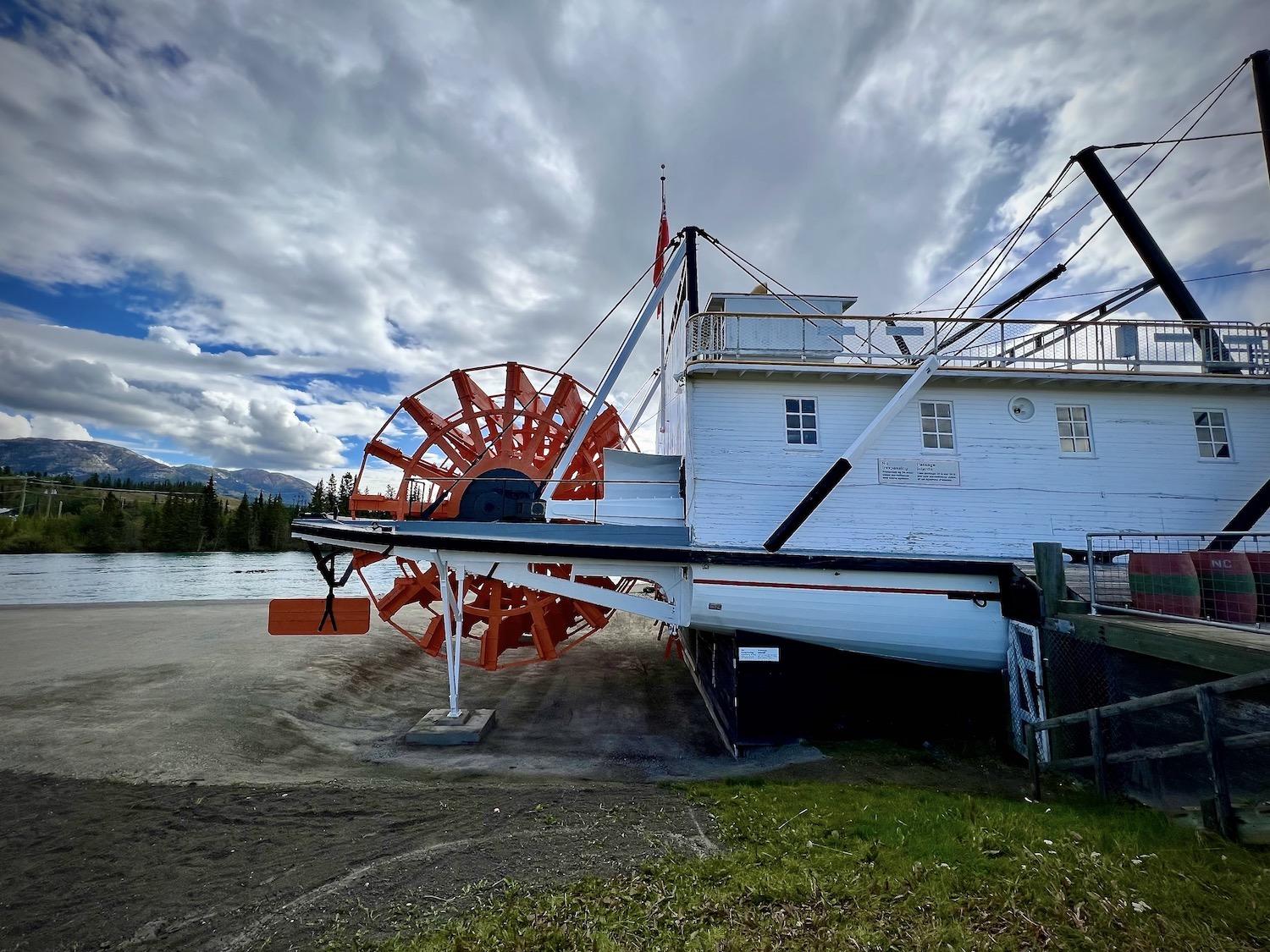
The S.S. Klondike is a sternwheeler from the golden era of Yukon riverboats/Jennifer Bain
There’s so much work to do for the barge and paddlewheeler.
Once they’re gone — once it gets to a certain spot — there’s no recovering the boat. It’s just way too massive of a job. Whereas, like a building you can always restud it and lift it up and it’s a square or a rectangle, it’s pretty easy. But these, once they’re gone they’re gone.
Tell me just nuts and bolts what you’re physically doing here at the Atlin?
So this one is getting all replaced with Douglas fir. The Klondike’s going to be reframed in yellow (cedar). So essentially what we’re doing is putting the structure back into the barge so we can have people on it and use it as a venue piece. Like I said, the shovel went through the deck and broke the back of the barge so there’s a lot of structural work to do.
And by shovel, what do you mean?
It’s like an excavator. A huge chunk of machinery. It makes sense now. All the framing was broken off on the top, they just like scabbed pieces in. And the shelf was chunks. You can see here where the stringers are cut because they were probably shattered and they just chopped them off, well I can’t have that. I’ve got to replace that. This will all be brand new inside and it will all be planked. And I want to put a viewing window when I’m finished, like a Lexan window about that wide, full length, and then light it all up inside with LEDs. Then when the people come down and have a look at it, they’ll be able to walk around the boardwalk but they’ll be able to see inside the boat and get an idea of what the structure looks like. Because it’s kind of boring looking at it — it just looks like a big rectangle when it’s planked.

Inside the S.S. Klondike, shipwright Terry Karlsen shows work he's doing to fix two staterooms/Jennifer Bain
And you’re working on both of these — the Atlin and the Klondike?
I’ve been given the go ahead to do the restoration on the boat, so I’m going to be pulling the whole wharf out before winter, sculpt all the soil back. It’s all going to be horded in. A big scaffolding operation. One of the biggest things about the boat right now is that it’s covered in lead paint and it’s right beside a fish-bearing stream — you know, the main artery of the Yukon? So that’s one big one. And the other one is, in order to work on the boat with impunity, you know to be able to do what you want to do, it’s got to be free of lead, or every time you go touch it, you’re got to hoard a whole section in — It’s like Chernobyl, right? So to avoid that, to see productivity increase, and give us the ability to maintain the vessel over a long period of time, the lead has to be abated, which is what we just did on the stern. I’ve only been here for about four years, so that was kind of the pilot project, at the back. We have new technology, scrapers are unnecessary. What we have is what’s called soda blasting now. And it uses sodium bicarbonate, so it’s very soft, it’ll take the paint off but it won’t affect the wood underneath. Unlike walnut shell or sand or something and you lose half the wood on the structure. This way you take the paint off, you’re left with a very clean substrate. You can seal it, paint it, no longer have to worry about lead content, right?
(Lead was once commonly used in paint as a rust inhibitor but is now strictly regulated. Removal of lead-based paint at this site is ongoing. During recent lead abatement work, the entire area was enclosed to protect the surrounding area. This included a double-layer floor plus wall and ceiling hoarding. Soil from the surrounding area was excavated and placed in covered containers to prevent leaching. All waste was transported to a licensed disposal facility. Parks Canada works with contractors, project partners and environmental agencies to ensure that the removal of lead paint doesn't impact the Yukon River.)
Where are you from?
I was born in Powell River (B.C.), raised in Terrace, and then did a little bit of a stint in the army. Then I come out of there and I fell in with some old Norwegian boat builders and they had been retired for quite some time but they took me under their wing and showed me all of this. Which you can never go to school for. You could just never find it. So I was very lucky, very fortunate.
What a great job you have.
Ultimately, it’s not for the money because you don’t get paid a lot here. It’s for the work and sharing the knowledge, which is disappearing really quickly, right. And there was one promise I made to my mentors — Ron Wallace and Chris Frostad and Arne Frostad. I mean it took me like 10 years just to get to the point where I was kind of doing my own work. They would only teach me if I promised to pass on the trade and that’s why I’m here — to fulfill that promise.
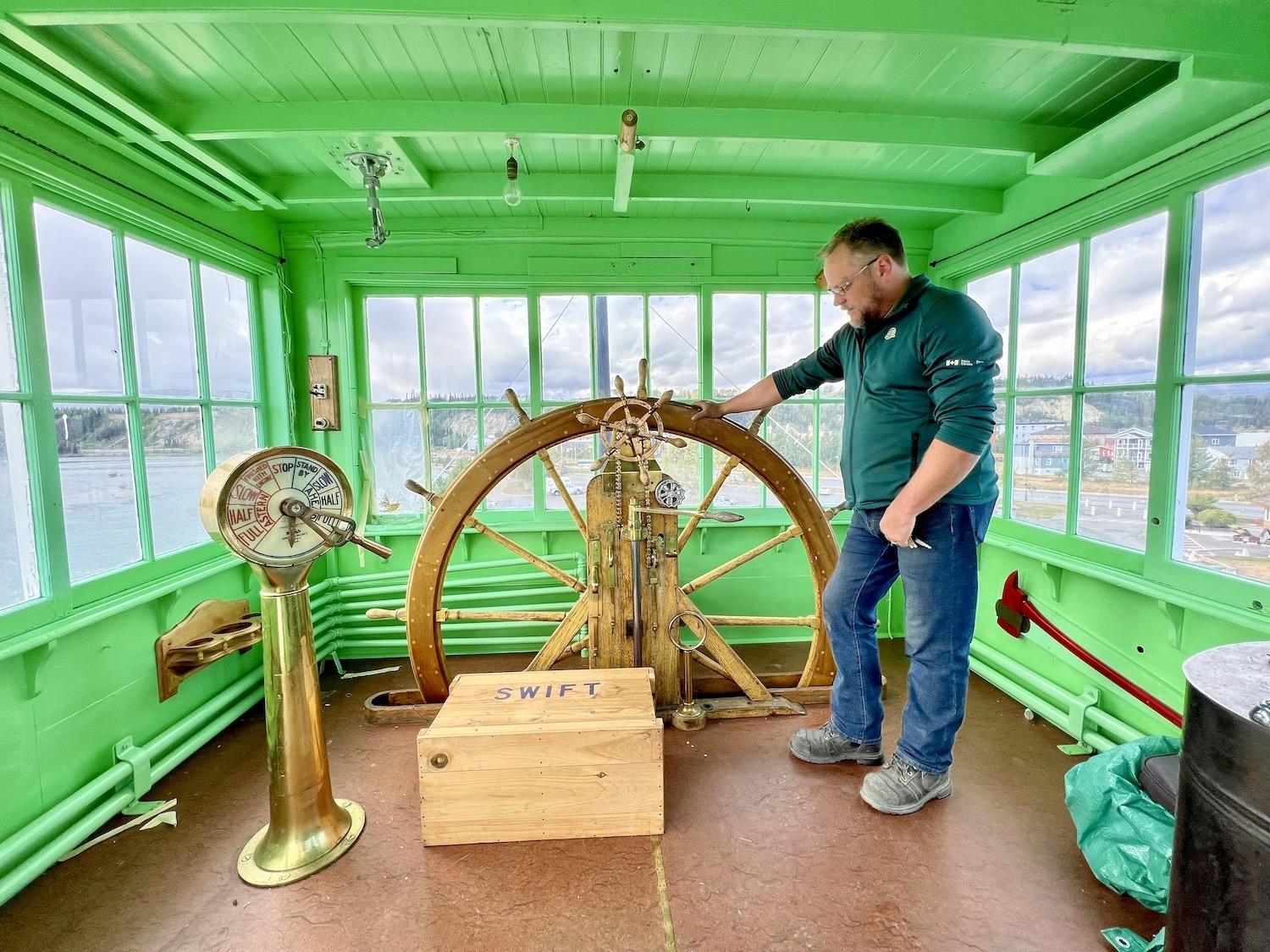
Shipwright Terry Karlsen stands in the S.S. Klondike's wheelhouse, which he hopes people will be able to visit again some day soon/Jennifer Bain
What’s the next step here?
I’m going to rip all of this wharf out, scallop that bank back, expose the boat in its entirety on both sides, and then you can get a good appreciation of it. Because when you look at it from the lawn, this almost looks like a building. It doesn’t really look like a boat because you can’t see the hull.
And your grand vision?
The idea with this thing (S.S. Klondike) is to get it to the point where I can have the public up in that wheelhouse and enjoy the full boat. Cater events out of the observation lounge. High tea on Wednesday. I built the little theatre up top (on the property). My dream is that people can get married or have a corporate event in there. They can go up into the observation lounge, have their reception or the dinner or whatever’s happening. Then they’ll have the Atlin Barge, they can have the band or the dancefloor or whatever else you want on this. And then hopefully I can get it to the point where I can have people stay on the boat overnight in some of the staterooms. But more importantly, it’s about letting the public enjoy something that’s such an important part of the heritage, right? And right now most of it’s shut down due to structural issues that don’t conform to today’s standards. But when I’m done, this is going to be the crown jewel of Parks Canada right here. I guarantee it. It’s going to blow people’s minds how awesome this is going to be.
I like your big, big, big thinking.
You've gotta have a dream, right?
This interview has been edited and condensed. Listen to part of their conversation:
When You Go To Whitehorse:
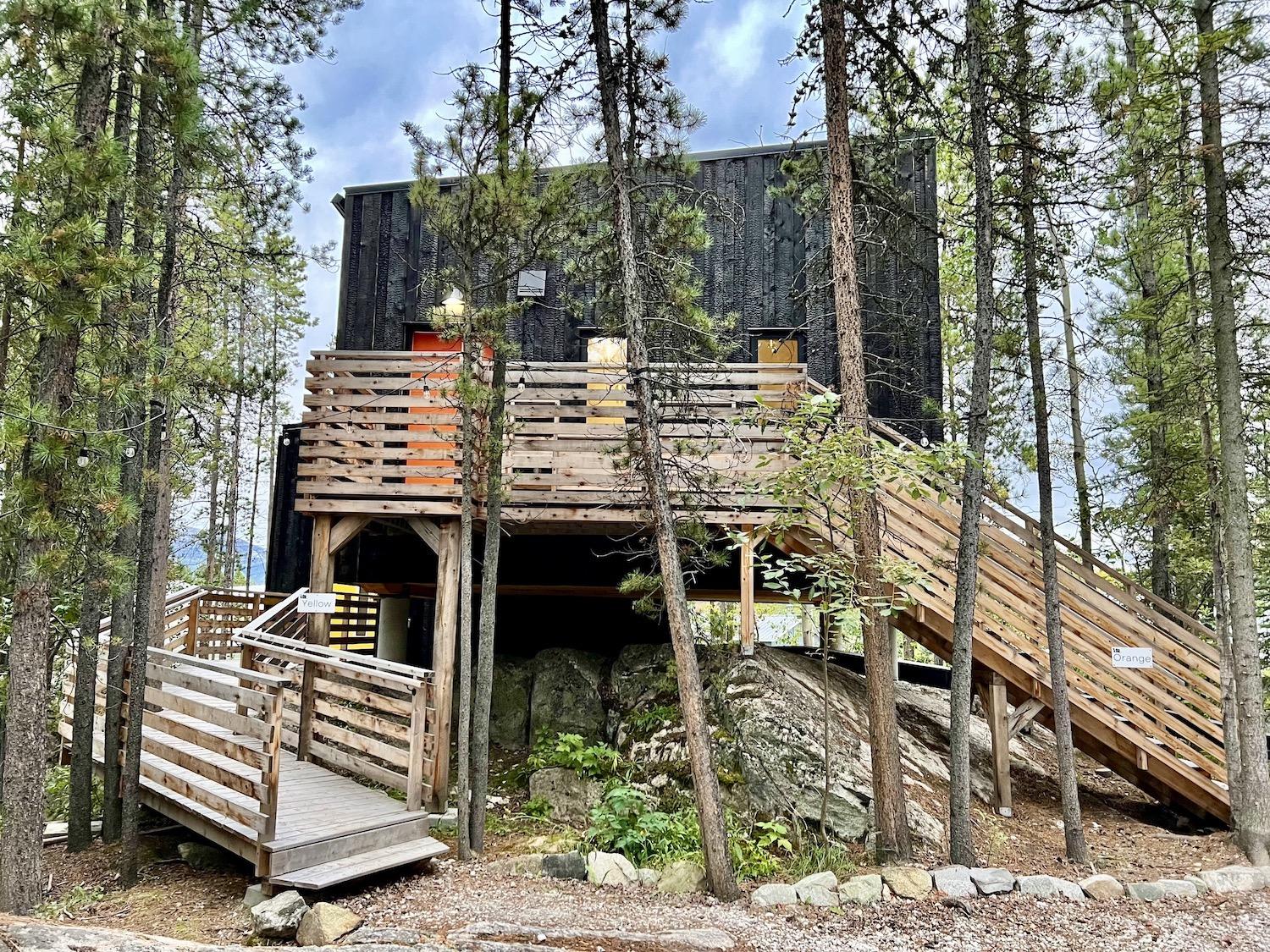
One of the four modern forest cabins at Black Spruce in Whitehorse/Jennifer Bain
I spent a night in the Black Spruce, a collection of four architecturally stunning wooden cabins built in 2019 and 2020 using passive solar design about seven minutes from downtown in a forest. The cabins are clad in Shou Sugi-Ban siding, a Japanese technique of treating wood by burning. These cabins are made from Yukon spruce and the black siding inspired the hotel’s name. The cabins are connected by a wooden boardwalk and each has a small "truth window" inside it that reveals the straw bale insulation. A wood-fired sauna features sustainably harvested clear grain cedar and its benches are built around boulders. I also spent a night in downtown Whitehorse at the stylish Raven Inn, the first major hotel built in Whitehorse in nearly 50 years.
On the food front, Klondike Ribs & Salmon is housed in the two oldest buildings still in use in Whitehorse. One part dates back to 1900. Known for serving ocean fish and local wild boar, elk and bison, the restaurant is famous for its Yukon sourdough bread pudding. The Raven Inn is also home to the Railwork Lounge, which makes a wonderful bison pot pie.
On The Road To Kluane National Park And Reserve:
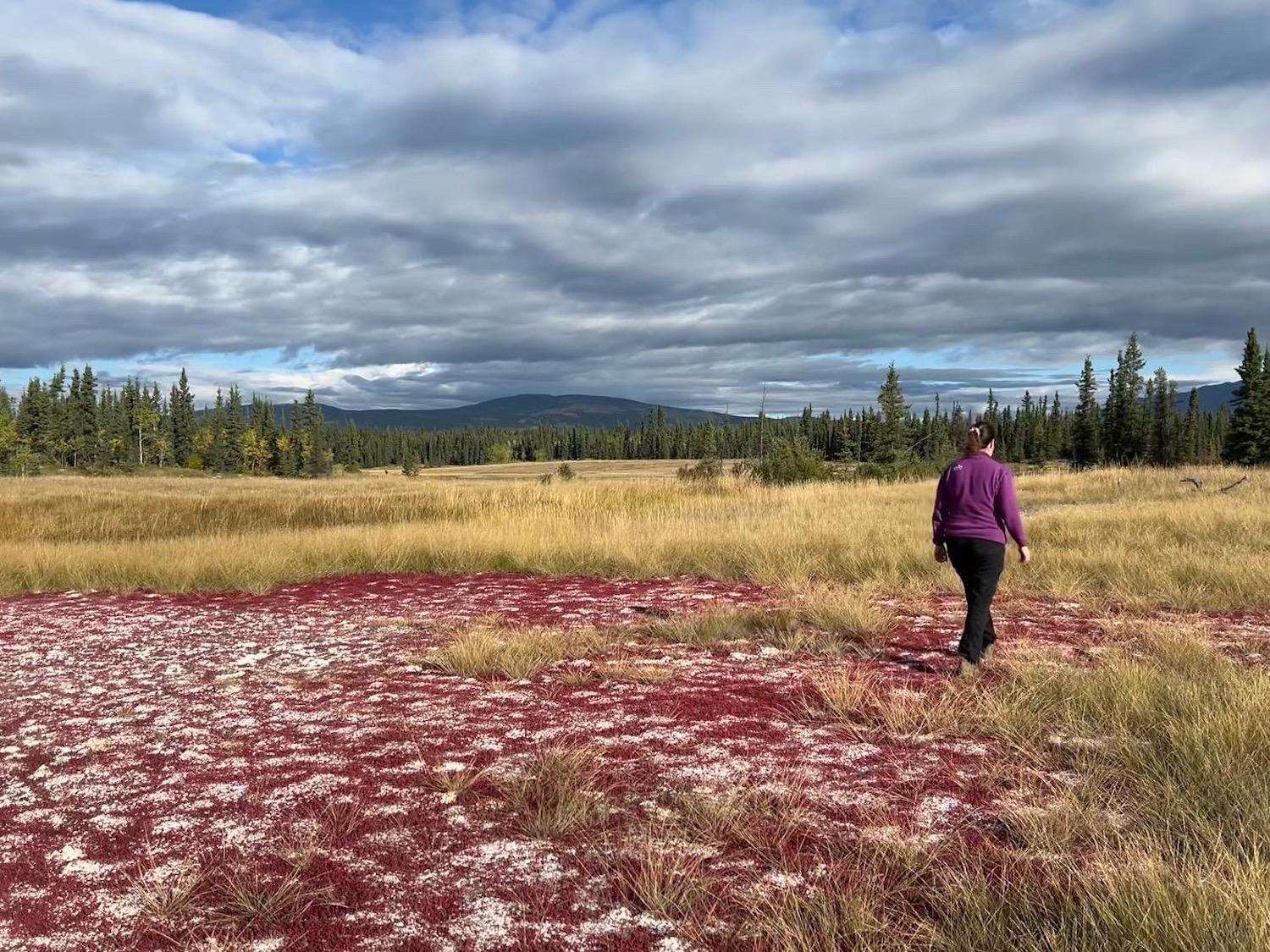
The Takhini Salt Flats were covered in mature red Arctic glasswort in September/Jennifer Bain
To get to Kluane National Park and Reserve, you'll take the Alaska Highway west from Whitehorse for about two hours. About a half hour into the road trip, you'll come to the unmarked Takhini Salt Flats just off the north side of the road east of the Takhini River Bridge. The Yukon News called the salt flats "one of the Yukon's best open geological secrets."
An interpretation panel at a nearby roadside rest stop with outhouses alerted me to the salt flats. It explains that as surface water evaporates, ground water is drawn upwards, taking naturally occuring salts to the surface. When I visited as fall approached, the flats were covered in Arctic glasswort (Salicornia borealis), a plant also known as sea asparagus that starts its life a dull green color but turns bright red when mature, and that thrives in the salty earth at this unusual site.


Add comment